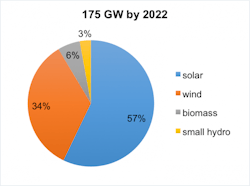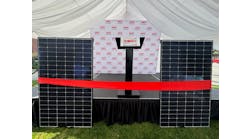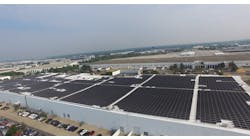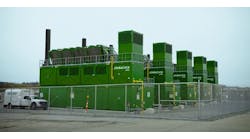Japan’s NEDO (New Energy and Industrial Technology Organization), Hitachi, Hitachi Systems and Itochu, in conjunction with the Delhi-Mumbai Industrial Corridor Development Corporation, are launching an industrial microgrid demonstration project in India.
Built to reliably supply power for a Mikuni India manufacturing facility in the Neemrana Industrial Park in northwestern Rajasthan, the hybrid solar-diesel microgrid is the first of its kind for the consortium partners, not only in India, but worldwide, a NEDO spokesperson told Microgrid Knowledge.
Integrating 1 MW of crystalline silicon solar PV with diesel-fuel power generation, the hybrid microgrid is designed to reliably supply stable, high quality power directly to Mikuni India, one of Japan’s largest automobile and motorcycle equipment and component parts manufacturers. That power generation capacity will be balanced with Mikuni India’s power demand via a communications network linked to a microgrid system controller.
Since July 2015 the project partners have also been testing a separate 5-MW of thin-film solar PV capacity at the industrial park in Rajasthan, home to what’s considered to be one of the most inhospitable natural environments on the planet, the Thar Desert. That thin-film-based solar PV generation capacity has been supplying emissions-free electricity to the public power grid since commissioning, but it will not be integrated into the microgrid demonstration platform.
A tough test of Japanese microgrid tech
Over the next two years, NEDO, Hitachi, Hitachi Systems and Itochu intend to test and evaluate the industrial microgrid platform’s ability to reliably meet the facility’s electricity needs while reducing diesel fuel power generation by more than 70 percent at daily maximum peak levels. This will significantly reduce carbon dioxide (CO2) emissions, according to NEDO.
They have also been evaluating the ability of Solar Frontier’s copper-indium-selenium (CIS) and Sharp and Kaneka’s thin-film silicon solar PV modules to produce power under the harsh desert conditions experienced at the Neemrana Industrial Park. Thin film’s performance will be compared to that of the crystalline silicon solar modules integrated into the microgrid.
Industrial microgrid demonstration project profile
-
Planned demonstration period: Japanese corporate FY2017-FY2019
-
Budget: Approximately $35.69 million; $31.35 million provided by NEDO
-
Participant companies: NEDO, Hitachi, Hitachi Systems, Itochu
-
Benefits to be demonstrated: – Practicality and energy efficiency of microgrid control technology in providing a reliable power supply – Effectiveness of Japanese PV modules
Project participants commissioned the demonstration microgrid system in advance of the two-year demonstration on August 11. Dependent on the facility’s electrical power needs and the price of diesel fuel over time, the value of electricity demand savings and CO2 emissions reductions will vary over time, according to NEDO.
The microgrid demonstration project is considered significant for the project consortium in that it will serve as a first live test of the Japanese companies’ microgrid technology. It’s also significant in that NEDO, Hitachi, Hitachi Systems and Itochu consider the microgrid demonstration as a prospective vehicle for encouraging dissemination of Japan’s microgrid technology across India, according to NEDO.
India’s Renewable Energy Targets
*Stanford Energy Club
As NEDO highlights, India’s economy is growing rapidly, and so is national electricity demand, which has been increasing at an average annual rate of 4.9 percent in recent years. As a result, India is expected to surpass the European Union as the world’s third-largest energy consumer by 2025, ranking behind China and the US. Chronic power shortages continue to hinder socioeconomic development, and it’s estimated that some 240 million Indians lack access to grid power.
The situation is particularly acute amid a backdrop of national energy policy that calls for universal electricity access and 175 GW of renewable power capacity to be installed by 2022 – 100 GW from solar power, 60 GW from wind power, 10 GW from biomass power, and 5 GW from micro-hydro power generation.
The Delhi-Mumbai Industrial Corridor is a significant aspect of India’s sustainable economic and energy development plans. A freight corridor – more specifically, a freight railway, will be constructed between Delhi and Mumbai with $4.122 billion of Japanese yen financing. The project plan also calls for private sector funding for the construction of industrial complexes, logistics bases, power plants, roads, ports, residential housing, commercial facilities, and other infrastructure, according to the Asia and Pacific Division of Japan’s Ministry of Economy, Trade and Industry.
Track news about industrial microgrid projects by subscribing to the Microgrid Knowledge newsletter. It’s free.







